
|

Boatsmen in Blekinge

|
These pages are about the boatsman in Blekinge, his family and his life. Since way, way back in time people and countries have been at war with each other. Finding soldiers willing to fight was not easy and the authorities solved the problems in different ways. They could for instance decide that for every 10th man in the village one had to be a soldier. Most of them were forced to against their will. The chance to come home from war was slight.
|
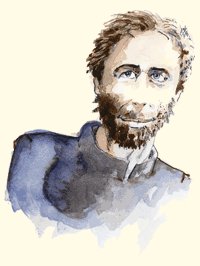
All pictures by Fredrik Franke
|
|
During the reign of King Carl XI
a new system was brought in in Sweden. The soldier was employed. He got a small dwelling, clothes and a salary that was paid by the farmers in the village. The group of farms employing one soldier was called a "rote" (division). The number of farms in a "rote" varied depending on how big the farms were.
|
|
Blekinge became Swedish
at the Peace of Roskilde in Denmark in 1658. Before that Blekinge was a Danish province. Quite soon after the Peace the Swedes built the towns of Karshamn and Karlskrona. Karlskrona became the naval head quarters for all of Sweden. Lots of people were needed to populate the new town, for the navy and the ship yard. To make it easier to find workers and seamen it was decided during the 1680´s that Blekinge and Södra Möre in the neighbouring county of Småland were to be divided into boatsmens companies. Since so many boatsmen were needed the system here got different to that of the rest of Sweden.
|
|
Here every "full homestead"
(a farm that had enough land to sow twelve barrels of grain) was to keep a boatsman. The farmer would be called "rusthållare" (boatsmans keeper). If it was a wealthy farm the farmer also had to pay tax apart from keeping the boatsman, but if it was a poor farm the farmer would be subsidised to help keep the boatsman. Since the farms often were small several farmers as a group kept a boatsman.
|
|
The parishes of Blekinge were divided into 3 boatsmans companies
|
|
|
1st company:
Förkärla
Listerby
Fridlevstad
Tving
Hjortsberga
Edestad
Ronneby
Backaryd
Hoby parishes
|
2nd company:
Kristianopel
Torhamn
Jämjö
Ramdala
Sturkö
Lösen & Lyckeby
Augerum
Rödeby
Nättraby parishes
|
3rd company:
Åryd
Hällaryd
Asarum
Mörrum
Elleholm
Ysane
Gammalstorp
Sölvesborg
Mjällby
Jämshög parishes
|
|
In Blekinge roughly 1500 boatsmen were employed. From the beginning these were fetched from Finland or other parts of old Sweden. They didn´t dare to employ people from the former Danish provinces. The Swedish powers didn´t trust them.
1845 förändrades indelningen till 6 kompanier men med totalt lika många man. 1887 upphörde systemet med den indelta armen, men den som redan var anställd fick fortsätta som båtsman eller soldat tills han fick pension. Sveriges siste båtsman, Sven August Wahlbom från Ramdala gick i pension 1932 och dog 1956.
|
|
Hans Svensson becomes a boatsman
|
Året är 1817
The young boatsman Hans Sjöström lives in Jämshög. He is only 18 years old. Last year he was enrolled in the 3rd Boatsmans Company. Then his name was Hans Svensson, but was given the name Sjöström when he was entered in the rolls.
|

|
|
|
These boatsmen had earlier served at the same place::
|

|
Name:
Anders Lång
Truls Lång
Mats Lång
Erik Lång
Per Lång
Truls Sjöström
Håkan Sjöström
|
Enrolled:
1685
1709
1713
1748
1750
1781
1808
|
The story continues ...
Hans Sjöström married Elna Persdotter from Ljusaryd in the parish of Jämshög. Together they had the children Sven, Ingegerd, Olof, Per and Carl. Hans served the navy for 30 years. He was dismissed in 1846 because of weakness in his hips and died four years later at the age of 50. He was punished several times by flogging. Once he was flogged 50 times for disobedience, fighting and drunkenness.
|
|
This is how Hans became a boatsman
|
|
When a boatsman for some reason left his service, the keeper had to find a new one. The applicant was to be between 16 and 36 years of age. He ought to be orderly, well grown, of good temper, healthy and sound. He had to have hair and at least have the ability to grow a beard.
|
|
General mustering
was done every third year and later every fifth year. Every boatsman was thoroughly checked. Anyone not up to standards were dismissed and new ones entered in the rolls.
|
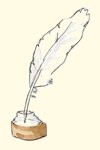
|
|
Hans had only just turned 17. He had hair and had only just started to grow a beard. He was approved of by the company commander and was entered in the rolls at the recruitment meeting the 16th May 1816, when he was also given his new boatsmans name Sjöström. But he was not formally accepted until the next general mustering. This was called to get approbation.
|
|
In Stora Rävsmåla in the parish of Backaryd lives the boatsman Nils Saktmodig with his wife Lovisa Håkansdotter and son Anders. His keeper has had lots of problems finding a good boatsman. Due to war and illness he has during the last couple of years time and time again had to look for new applicants. Nils and Lovisa married in 1812, two years after Nils had been enrolled as a boatsman in the 2nd Boatsmans Company. Nils and Lovisa had lost two children. A little son and a daughter died very young.
|
|
These boatsmen had served before him at this place:
|
|
|
Name:
Gumme Saktmodig
Måns Saktmodig
Sven Saktmodig
Jöns Saktmodig
Håkan Saktmodig
Johan Saktmodig
Peter Saktmodig
|
Enrolled:
1724
1788
1807
1809
|
|
The story continues ...
Nils served on several ships and he was well used to the sea as well as well travelled, which meant he could stand by the rudder and steer the ship. In 1821 the boatsmans name at this dwelling was changed to Stilla (Still) which didn´t really suit Nils, since he already the same year ran off from his service but was apprehended after a month of freedom.
|
"Lega"
A lumpsum on employing the boatsman. The fee could vary in size. This depended among other things on the nature of the other perks.
|
|

Salary
A smaller sum of money paid out twice a year, autumn and spring.
|
"Hemkall"
Goods that the boatsman and his family got in order to survive in the dwelling place. The contents varied with different contracts
In Blekinge the ""Hemkall"" could consist of:
|

firewood
|

grazing for
the cow
|

two barrels of grain
|

a hay load
|
or:
land, meadow and a barn
|
Clothing
These things were to last for three years and were only handed out when the boatsman went off on service.
|

a hammock
|

a travel bag
|

a blanket or rug
|
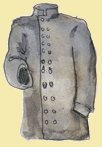
kapprock
|
|
Clothes
Annually:

 a scarf
a scarf
a woolen hat
|
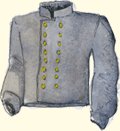
a lined woolen jacket
|


a pair of woolen trousers
|
en väst av vadmal med ärmar
|

two shirts

one pair of leather shoes
one pair of socks

|
|
The clothes were made by the village tailor from standard patterns. When they were worn out the boatsman could use them as he pleased. Many clothes were made from "vadmal" a warm homespun woolen material.
|
In boatsman Stillings house

|
In Stilleryd in the parish of Asarum lives Anders Stilling. He is 23 years old and has been a boatsman since 1811. Before he got his boatsmans name his name was Anders Christiansson.
These boatsmen served here before him:
|
|
|
Name:
Johan Björn
Mårten Björn
Zackarias Stilling
|
Enrolled:
1716
1731
1799
|
|
The story continues ...
Anders Stilling married Catarina Persdotter and in 1826 they had their daughter Ingrid-Maria. Anders served on board several ships, among others the gunboat Carl von Hedini and the brig Delfin. He was well travelled, that is: he had at least experienced 2 voyages on foreign waters. On the 13th of January 1833 Anders Stilling drowned at the age of 39.
|
The boatsmans dwelling
|
|
The boatsman and his family was to have a house to live in. The house looked like other houses in the area , but it was smaller and more humble. In the dwelling house there was a room with an open fire or a stove, a small hallway and a little side room.
|
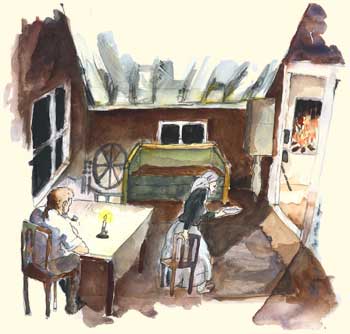
|
|
The boatsman also ought to have a stable with room for a couple of cows and a small piece of land to grow turnips, potatoes and a few vegetables on. Some times all the boatsmens dwellings of the village were gathered around the village green. But more often they were spread around the edges of the village on the poorest of soil. It was not unusual for the boatsman to live in with his keeper since there wasn´t a boatsmans house.
|

|
In Hosaby
|
|
In Hosaby in the parish of Mjällby Sven Hattmakare is boatsman. He is 29 years old. Earlier on he served as a ”double” boatsman. This meant that he had to join in to serve in case a war broke out. 1908 he married the maid Kersta Persdotter from Hörby. In 1811 he became one of the 89 fully accepted boatsmen in the parish of Mjällby and could move to a little dwelling in Hosaby.
|
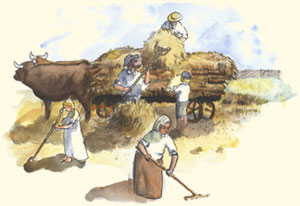
|
To get their daily bread the whole family had to help with the chores at the dwelling. The boatsman could earn a little bit extra by taking on shoemaking, tailoring, painting, brick-laying or some other crafts but he was not to compete with the village craftsmen. The family was also expected to help out at the keepers farm.
|
|
The Church Parade
|
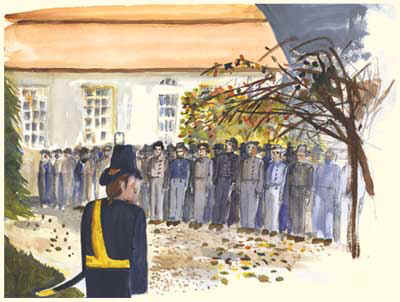
|
|
Some Sundays the boatsmen were to gather by the church dressed in their uniforms. The corporal was in charge and led the drill. Before the church bells summoned for service the boatsmen were lined up and inspected by the corporal. If a boatsman had misbehaved or been careless with his uniform this had to be reported to the company commander.
|
The story continues ...
In his marriage with Kersta 8 children were born. Three died very young. Sven served the Navy for 30 years. He made several voyages and served on among others the frigate Galathea. Sven Hattmakare suffered from a groin hernia and was dismissed at the aged of 53. He had to leave the dwelling, but he got a pension of 12 Riksdaler Banco a year and moved with his family to another house on the keepers farm. He died in 1849.
|
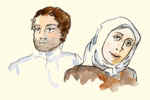
|
The year is 1817
I Hammarby i Jämjö socken bor Olof Råå 44 år gammal. Han är antogs vid 2:a båtsmanskompaniet år 1794. Olof bor tillsammans med andra hustrun Karin Jonsdotter och sina söner från det första äktenskapet med Karin Persdotter, som dog av feber några månader efter sonen Samuels födelse.
|
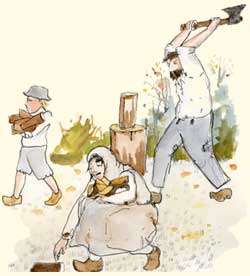
|
The story continues ...
Karin Jonsdotter and Olof Råå never had any children together. They married in 1810 and she passed away in 1832. The year after he got married again to Helena Magnidotter who by then was already expecting their daughter Ingrid Catarina. Olof was 60 years old when the daughter was born and had been dismissed in 1831. Olof served the Navy for 37 years and died of old age at 73 years of age.
|

Boatsmans names
|
|
When the boatsman was enrolled, he was given a boatsmans name. The name usually followed the dwelling place. Olof Råås´ name was Olof Persson before he became a boatsman. From the beginning many boatsmen were given names that depicted a special feature. A tall man could be named Stor [Tall], a fair haired person could be called Vitlock [Whitelocks], but quite often the name was not depicting the person at all, since it was inherited with the dwelling place. The boatsmen could also be named from places. Netterstedt and Netterman lived in Nättraby.They could be named from the flora like Alm [Elm], Ask [Ash] and Björk [Birch] or from animals like Abborre [Perch] and Kråka [Crow]. It was also common to use weapon or ship details when allocating names. A boatsman could be called Ankare [Anchor], Svärd [Sword] or Flaggstång [Flagpole]. Some names were probably not very amusing to have. Who would like to be called Buffel [Buffalo] or Menlös [Harmless]?
|

The Service
|
|
When it was time for the boatsman to go to Karlskrona to serve the summons was read out in church. Then the keeper had to bring out his chest with the things the boatsman only was allowed to use when in service. The keeper had to make sure it was transported together with food supply to the gathering place. The boatsman could get a lift as well. From the gathering field the trip then continued by boat or horse carriage to Karlskrona. Råås´ keeper took him and his things all the way in to Karlskrona since it wasn´t very far away from home.
|
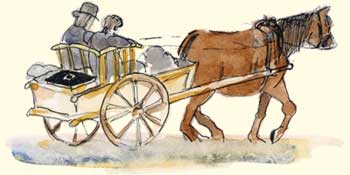
|
The boatsmen were renowned for their rowdy behaviour on their journeys in to Karlskrona. They drank spirits, shouted and sang, so that no one could avoid noticing them.
The boatsmens tasks in Karlskrona was guarding, drills, working at the ship yard or serving on board the Navy´s ships.
In times of peace and if the boatsmen weren´t sent on a long voyage they used to work for four months every year in Karlskrona. During the service on land they had to supply themselves with board and lodging.
1846 the boatsmens quarters was built on Stumholmen. Here the boatsmen slept in long rows in their hammocks.
|
|
The boatsmen come to Karlskrona
|
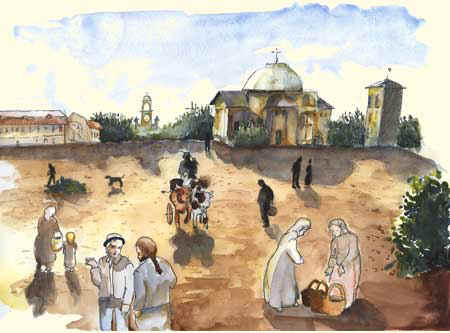

|
|
On boats, with horse carriages or by foot the boatsmen arrived to the service in Karlskrona. The city people at first tried to stay indoors, because they knew it could be loud and lively. Curious boatsmen went round town to see if everything was the same as the last time they were there.
|
|
|
The boatsmans work on land consisted of
military training, guarding and work at
the royal navy ship yard and workshops
|
|
|
|
At sea
|
|
Going on a long voyage was a big experience for the boatsman. Anders Stilling, Sven Hattmakare and Olof Råå had all been on long journeys to far away countries. But the boatsmans main duty was obviously to serve on board the ships in times of war. The tasks were to man the cannons, climbing the masts and stand by the rudder. Life on board was hard. The ones who were not injured or killed in battle could have accidents or illnesses.
|
|
The discipline on board was very strict. Common crimes were running away, theft and drunkenness. It happened quite often that the boatsman never turned up for duty. The punishment was often flogging, often in the way of "gatlopp" (road running), which meant that the man had to run between two rows of men with whips in their hands.
|
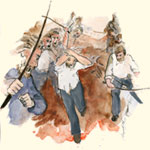
|
Food list
for a team of eight decided in 1782
Morning
Mon, Wed, Sat
Butter, spirits
Tues, Thurs, Fri, Sun
Salted herring, spirits
Lunch
Mon, Thurs
Sour Cabbage, oats, pork
Tues, Fri
Peas, oats, salted meat
Wed, Sat
Peas, oats, salted herring
Sun
Salted meat and a pudding made from wheat flour and butter
Supper
Every day
Barley groats, butter, spirits
|
Apart from this the team had bread to eat with their meals, vinegar to mix in the water and garlic essence that was to be put in the morning spirits. On special occasions tobacco and extra rations of spirits wera handed out. Fresh meat and fish would be served when available, as well as vegetable soup.
|

|
|
The crew on a liner consisted of approximately 580 men. Of these about 250 were boatsmen. During battle many of the boatsmen manned the cannons.
|

|

|
When the service was over it was time to travel back to the dwellings and the village, where the wife and children had looked after the house and land as best they could. The keeper had to help with things that the family couldn´t manage while the boatsman was away. Everybody was hoping that father would bring back a little gift.
When he had been on a long journey one could hope for something really special. Perhaps a sea shell from far away oceans.
|
Christmas food
At Christmas time the boatsman went round to the keeper or the group of keepers. First he went to the most generous of the keepers wives, because no one wanted to give less than the others. He could be given bread, Christmas candles, meat and cheese. And spirits, always spirits and in every house he was treated to as much as he could take. When Hans Sjöström from Jämshög went round the farms with his bag, Elna went with him. She didn´t go in the house but kept an eye on him so that he wouldn´t stoop over in a snow drift and fall asleep with all the good Christmas food in the bag.
|

|
|
The boatsman was to serve for as long as he was capable of war service. He could be dismissed for incapability, weakness or old age. The pension, the so called "gratial" was handed out to those who suffered ill health because of their service or after long and faithful service. Different amounts were paid out if he had served 15 or 30 years. Healthy men had to be over 60 years old to receive a "gratial". The dismissed boatsmen and his family had to leave the dwelling and they often had a hard time.
|
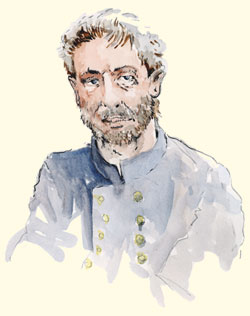
|

|
Sven Hattmakare had served the Navy for 30 years when he was struck by groin hernia and was dismissed. His pension was 12 Riksdaler Banco. He had to leave his boatsmans dwelling, but could move in to another little house on his keepers farm.
|
Båtsmansboken is an introduction for anyone interested in boatsmen. It is produced by a project called
Rötter and Vingar, [Roots and Wings], a cooperation between the Blekinge County Museum, the Maritime Museum and the Schools of Karlskrona.
You find the original edition at Blekinge Museum's home page, they say that all material is free to use and copy. We publish "Båtsmansboken" in order to reach more people and perhaps create some more interest for our great museums in Karlskrona.
Translation from Swedish was done by Eva Cumner.
|
|
|

|
